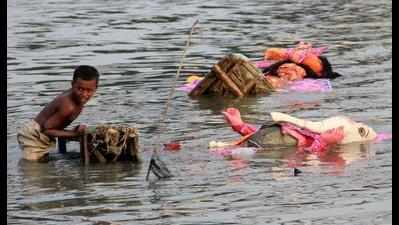- News
- City News
- kolkata News
- Hooghly lead count up post immersion
Trending
This story is from October 16, 2016
Hooghly lead count up post immersion
The final round of immersions left the Hooghly contaminated with lead content shooting up to over three times the permissible limit. Dissolved oxygen in the river plunged by at least seven times while oil and grease count rose by about four times, according to a study by green NGO Saviours and Friends of Environment (SAFE) and the department of environmental studies, Rabindra Bharati University.

KOLKATA: The final round of immersions left the Hooghly contaminated with lead content shooting up to over three times the permissible limit. Dissolved oxygen in the river plunged by at least seven times while oil and grease count rose by about four times, according to a study by green NGO Saviours and Friends of Environment (SAFE) and the department of environmental studies, Rabindra Bharati University.The impact on the water was far more severe than last year, the survey claimed, which also proved that contrary to their claims, the majority of the organizers still used lead paint on idols.
Conducted across Cossipore Ghat, Bagbazar Ghat, Nimtola Ghat, Baje Kadamtala Ghat and Panihati Ghat, the survey recorded an average lead count of 0.057 mglitre on October 13.Bagbazar Ghat topped the chart with 0.068 mg. On October 14, the average lead count dropped to a relatively healthy 0.02 mg, still considerably above the permissible limit of 0.01. Lead has been an issue of concern for the last several years with green activists and the state pollution control board jointly launching a campaign to curb its use. The latter had even distributed leadfree paint among Kumartuli artisans to encourage its use.
“Unfortunately, the campaign didn't yield any result. It is evident from our readings that lead paint is being widely used. Being a volatile metal, it spreads very fast in the water and disturbs the ecological balance. Aquatic plants and animals are the first to be affected, leading to a bio-magnification of lead through the food chain. Coupled with the decline in dissolved oxygen content, lead poses the biggest threat to the biodiversity of the Hooghly,“ said Sudipto Bhattacharjee, green activist and secretary of SAFE.
Green activist Subhas Datta agreed. The idols could have been pulled out faster from the water after immersion, Datta felt. “Cranes were used, but the advanta ge was lost since the idols were left in water for at least 45 minutes. This was enough for lead to seep into the water and leave it contaminated. Less than 10% of the idols could actually be lifted quickly enough to prevent seepage of colour, chemcials and lead. The use of cranes turned out to be more symbolic than effective,“ Datta pointed out. Only two of the ghats -Baje Kadamtala and Nimtola -had cranes. “The rest used manual techniques to lift the idols. Also, idols were left floating in the water in a bunch at several immersion sites. This allowed considerable seepage of lead into the water at Cossipore, Bagbazar and Panihati.Even flowers and idol ornaments were not fully removed before immersions at Bagbazar and Cossipore,“ said Bhattacharjee.
Dissolved oxygen count dropped to 1.3 mglitre across the ghats, a seven-time plunge. It was dangerous for aquatic plants and animals since most fail to cope with a sudden oxygen drop, added Bhattacharjee.
Conducted across Cossipore Ghat, Bagbazar Ghat, Nimtola Ghat, Baje Kadamtala Ghat and Panihati Ghat, the survey recorded an average lead count of 0.057 mglitre on October 13.Bagbazar Ghat topped the chart with 0.068 mg. On October 14, the average lead count dropped to a relatively healthy 0.02 mg, still considerably above the permissible limit of 0.01. Lead has been an issue of concern for the last several years with green activists and the state pollution control board jointly launching a campaign to curb its use. The latter had even distributed leadfree paint among Kumartuli artisans to encourage its use.
“Unfortunately, the campaign didn't yield any result. It is evident from our readings that lead paint is being widely used. Being a volatile metal, it spreads very fast in the water and disturbs the ecological balance. Aquatic plants and animals are the first to be affected, leading to a bio-magnification of lead through the food chain. Coupled with the decline in dissolved oxygen content, lead poses the biggest threat to the biodiversity of the Hooghly,“ said Sudipto Bhattacharjee, green activist and secretary of SAFE.
Green activist Subhas Datta agreed. The idols could have been pulled out faster from the water after immersion, Datta felt. “Cranes were used, but the advanta ge was lost since the idols were left in water for at least 45 minutes. This was enough for lead to seep into the water and leave it contaminated. Less than 10% of the idols could actually be lifted quickly enough to prevent seepage of colour, chemcials and lead. The use of cranes turned out to be more symbolic than effective,“ Datta pointed out. Only two of the ghats -Baje Kadamtala and Nimtola -had cranes. “The rest used manual techniques to lift the idols. Also, idols were left floating in the water in a bunch at several immersion sites. This allowed considerable seepage of lead into the water at Cossipore, Bagbazar and Panihati.Even flowers and idol ornaments were not fully removed before immersions at Bagbazar and Cossipore,“ said Bhattacharjee.
Dissolved oxygen count dropped to 1.3 mglitre across the ghats, a seven-time plunge. It was dangerous for aquatic plants and animals since most fail to cope with a sudden oxygen drop, added Bhattacharjee.
End of Article
FOLLOW US ON SOCIAL MEDIA










